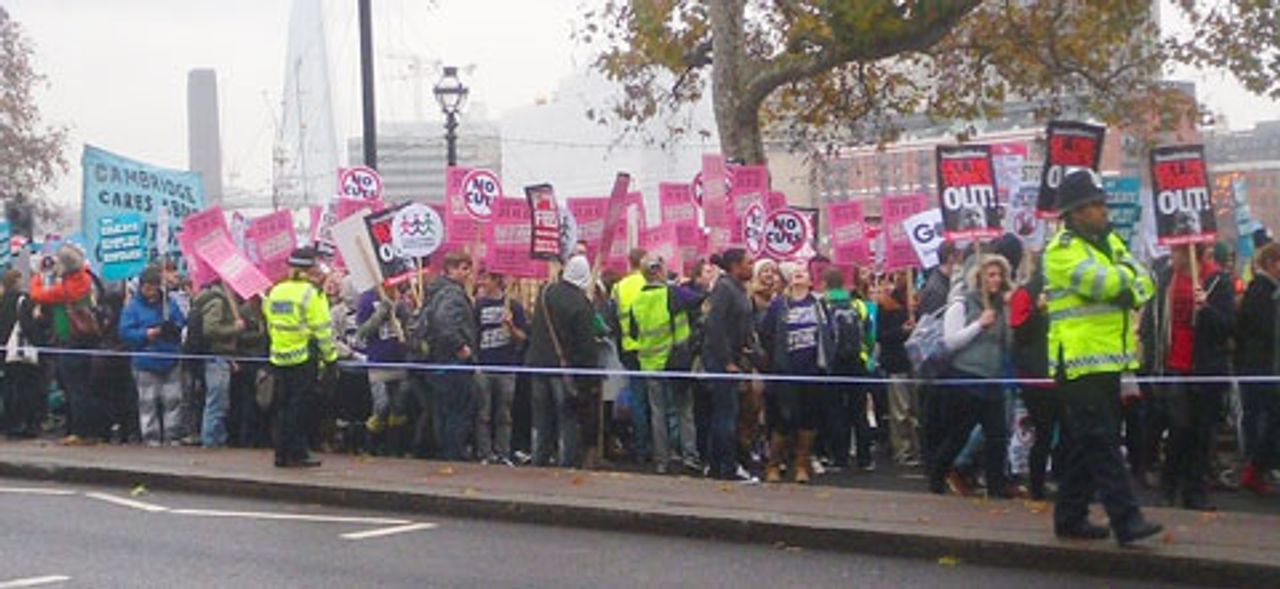Students marched through London on November 21 in protest against the trebling of tuition fees to £9,000, cuts to education, increasing living costs, the scrapping of the Education Maintenance Allowance and rising youth unemployment. Students also carried banners opposing the Israeli bombing of Gaza.
 Some of the protesters on the march
Some of the protesters on the marchThe march was called by the National Union of Students (NUS) under the slogan, “Educate, Employ, Empower”. It was the first public demonstration of the NUS since the student protests in 2010, which saw thousands of university students, sixth-form students and school pupils demonstrate in many cities. Students suffered vicious attacks by the police, including cavalry charges and kettling in freezing conditions followed by a nationwide media-led witch-hunt and arbitrary arrests and trials.
The NUS earned the enmity of the majority of students when its then-president, Labour’s Aaron Porter, condemned the protests after students occupied the Conservative headquarters at Milbank Tower and laid the blame for violence with students. On the last day of protests, when the tuition fee rise was being voted on, thousands of students demonstrated outside parliament while the NUS decided instead to hold a candle-lit vigil on the Thames numbering in the low hundreds.
Last week’s march was an attempt by the NUS bureaucracy and ex-left tendencies such as the Socialist Party and Socialist Workers Party to resuscitate the NUS. In an interview, Porter’s replacement, Liam Burns, acknowledged that Porter’s denunciations had not helped the NUS, calling it a “difficult time” for the organisation. He claimed that since then, there had been a “process of reconciliation…that was successful” and “we feel in a much more comfortable place now”.
While calling for a “democratic and fighting NUS that will confidently argue against cuts, give a lead, and prepare a strategy to win,” the Socialist Party dutifully urged “students, lecturers and workers to march together again on the NUS-organised demonstration in London.”
The Socialist Workers Party in its short article advertising the march made no mention of the NUS in order to avoid criticising the organisation.
In the event, the NUS’s anticipated and fairly modest attendance of 10,000 failed to materialise, with fewer than half that number participating.
The NUS routed the march through central London so as to drag it out over miles to Kennington Park. As the demonstration passed close to parliament, a section of protesters attempted to break through the heavy police cordons and a small sit-in was attempted at Westminster Bridge, ending in a scuffle with police.
Fewer still remained at the end of the march to listen to Burns and an assortment of trade unionists from the University and College Union, Unite and Unison denounce criticisms of the NUS and make nationalist appeals for the government to recognise the need for higher education to make Britain great again.
At the final rally, eggs were thrown at Liam Burns. The microphone was cut off to prevent any unofficial statements being read out.
In an interview with the Guardian, Burns attacked any notion of strikes as outdated in the twenty-first century while claiming that the NUS campaign in 2010 had “shaped the narrative of the coalition government”. Turning a blatant defeat into a victory, he continued, “We got shed loads of concessions out of the new tuition fee system because of the [Liberal Democrat] pledge campaign…. It was powerful and effective.”
So effective that tuition fees were trebled!
The NUS statement said in the most non-confrontational terms imaginable that students had to ensure that at the next general election “those who claimed to represent us can’t betray us again.”
The National Campaign Against Fees and Cuts (NCAFC) was formed in February 2010, co-founded by Michael Chessum, who writes in the Guardian. Following the betrayal of the NUS, the NCAFC played a prominent role in the subsequent protests and is still advanced as a radical alternative to the NUS. In reality, aside from various protest stunts, the NCAFC offers very little that is substantially different.
Chessum is a National Executive Committee member of the NUS who stood in the election for the position of Vice-President Higher Education. Other NCAFC committee members include Jamie Woodcock, a Socialist Workers Party member and an NEC member who stood in the election for Vice-President Society and Citizenship.
The dispute between the NCAFC and NUS centres on the calculation that the present leadership is so compromised that there is a danger of a movement developing outside of its control. The NCAFC’s purpose is to rein in such a development and direct disaffected students back towards the NUS.
Receive news updates and information on the fight against the unsafe reopening of schools.
